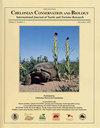墨西哥湾坎普雷德利海龟种群承载能力的下降是否导致了2010 - 2017年产卵量的下降?
IF 0.8
4区 生物学
Q3 ZOOLOGY
引用次数: 18
摘要
Kemp's ridley (Lepidochelys kempii)是世界上最濒危的海龟物种。1966年至2017年期间,在墨西哥塔毛利帕斯州(Tamaulipas)的墨西哥湾(GoM)指数海滩上,每年的巢穴数量(即产卵的数量)被用作Kemp ridley筑巢雌性丰度的年度指数。该指数在2009年以每年19%的速度呈指数级增长,但在2010年出人意料地下降了三分之一以上,到2017年仍远低于预期水平。我们推测,2010年前墨西哥湾内坎普雷德利种群的承载能力下降是造成筑巢减少的原因。我们讨论了2010年前可能导致承载力下降的因素,包括墨西哥湾生态系统的退化、肯普雷德利种群的指数级增长以及肯普雷德利食物(包括自然猎物和捕虾拖网捕捞的废弃副渔获物)的人均可得性下降。我们鼓励对这一假设进行评估(特别是在一个强大的建模框架内),并提出其他解释筑巢挫折的假设,以提供指导种群恢复进程所需的信息。本文章由计算机程序翻译,如有差异,请以英文原文为准。
Did Declining Carrying Capacity for the Kemp's Ridley Sea Turtle Population Within the Gulf of Mexico Contribute to the Nesting Setback in 2010−2017?
Abstract The Kemp's ridley (Lepidochelys kempii) is the most endangered sea turtle species. During 1966–2017, an annual count of nests (i.e., clutches of eggs laid) has served as an annual index of Kemp's ridley nesting female abundance on the Gulf of Mexico (GoM) index beach in Tamaulipas, Mexico. This index was increasing exponentially at 19% per year in 2009, but it dropped unexpectedly by more than a third in 2010 and through 2017 remained well below levels predicted. We hypothesize that pre-2010 declining carrying capacity for the Kemp's ridley population within the GoM contributed to this nesting setback. We discuss pre-2010 factors that may have caused carrying capacity to decline, including degradation of the GoM ecosystem, the exponentially increasing Kemp's ridley population, and declining per capita availability of neritic (i.e., postpelagic) Kemp's ridley food, including natural prey and scavenged discarded bycatch from shrimp trawling. We encourage evaluations (especially those within a robust modeling framework) of this hypothesis and others put forth to explain the nesting setback to provide information needed to guide restoration of the population's progress toward recovery.
求助全文
通过发布文献求助,成功后即可免费获取论文全文。
去求助
来源期刊
CiteScore
1.70
自引率
14.30%
发文量
17
审稿时长
>12 weeks
期刊介绍:
Chelonian Conservation and Biology is a biannual peer-reviewed journal of cosmopolitan and broad-based coverage of all aspects of conservation and biology of all chelonians, including freshwater turtles, marine turtles, and tortoises. Manuscripts may cover any aspects of turtle and tortoise research, with a preference for conservation or biology. Manuscripts dealing with conservation biology, systematic relationships, chelonian diversity, geographic distribution, natural history, ecology, reproduction, morphology and natural variation, population status, husbandry, community conservation initiatives, and human exploitation or conservation management issues are of special interest.

 求助内容:
求助内容: 应助结果提醒方式:
应助结果提醒方式:


